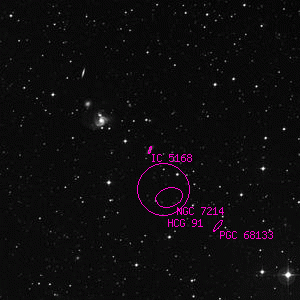IC 5168

Overlaid DSS image of IC 5168, 30' x 30' with north at top and west to the right
Aladin viewer for the region around IC 5168
MCG-05-52-039, ESO 467-15, PGC 68164
| Type | Galaxy |
|---|---|
| Magnitude | 14.2 |
| Size | 0.783' x 0.188' @ 165° |
| Right Ascension | 22h 9' 16.3" (2000) |
| Declination | 27° 43' 49" S |
| Constellation | Piscis Austrinus |
| Description | eeF, vS, mE, 2 F st |
| Classification | 4.0 |
Observing Notes
Harold Corwin
In a July 2019 email, Steve Gottlieb points out that the galaxy nearest to Swift's position, ESO 467-G011 (V = 14.9) does not have the faint stars nearby mentioned in the original descriptions: "eeF, vS, vE, right angled triangle with 2 F sts near sf" (but see below). This description is from Swift's Popular Astronomy (5, 426, 1897) List No. 3 of nebulae found at Lowe Observatory, and is the most complete account of the galaxy and its nearby stars that he published. In his other two List 3's (in MN 52, 631, 1897; and PASP 9, 223, 1897), Swift describes the stars somewhat differently: "... right angled triangle with 2 F sts near" and "... forms right angle 2 vF close stars [no 'with' in this one]." Finally, in his big combined "Catalogue No. 11 of Nebulae" in AN 3517, he simply says "...[triangle] with 2 F sts", where "[triangle]" is a triangle symbol.
Steve goes on to say, "In this case, I can suggest perhaps a better candidate. ESO 467-015 = HCG 91B, about 10' NE of Swift's position, is a slightly brighter edge-on (still quite faint in my 18") with two mag 14.5 stars less than 2' ne and se forming an equilateral triangle. Another possibility is that Swift made a re-observation of NGC 7214, which also has two nearby mag 13 stars, though s and sw. NGC 7214 isn't noticeably elongated visually (to me), though if you include HCG 91D = PGC 68155 at the north edge, it could appear elongated N-S."
Given Swift's account of the flattening of the galaxy as "vE", I can't give much credence to the idea that Swift was observing the brighter NGC galaxy, nor, from his email, do I think Steve does either. However, ESO 467-015 (V = 14.2) looks like it fits Swift's description reasonably well -- aside from the relative position of the two stars. Even taking Swift at his word -- in three out of the four accounts he published -- he claims that the galaxy makes a "right angled triangle" with the stars. This is at odds with Steve's far more accurate "equilateral triangle", which does indeed describe ESO 467-015 and its accompanying stars very well.
Looking at the usual identification, ESO 467-G011, I notice that there are two stars north -- not south -- and east that form another nearly equilateral triangle. The stars, however, are not particularly faint (ASAS3 makes them V = 11.40 and 12.85). Could the fact that all these objects were only 30 degrees above Swift's southern horizon at Mt. Lowe have introduced enough extinction to make the stars appear "faint"? The other problem with this interpretation is that in one description, Swift says "2 vF close stars" -- does he mean the stars are close to his nebula, or close to one another? I would not call these two stars "close" in either case, but Malcolm Thompson has pointed out that Swift uses the nearly-synonymous word "near" for stars that are as far away from his nebulae as eight to ten arcminutes. Given that, 2.5 to 3 arcminutes is indeed "close". But the stars near ESO 467-G015, at 1.7 and 1.8 arcminutes, are "closer".
So, in the end, we have two candidate galaxies for Swift's object and conflicting evidence from his position and descriptions:
1) Swift's position is nearly coincident with ESO 467-G011.
2) His description of the nebula could fit either ESO 467-G011 or -G015.
3) ESO 467-G015 (V = 14.2) is brighter than -G011 (V = 14.9), so is more likely to have been seen by Swift.
4) Both galaxies form triangles with nearby stars, though neither triangle is the right triangle that Swift describes.
5) The stars near ESO 467-G011 would better match Swift's description if he made a mistake, calling them "south following" rather than "north following" as they really are.
6) But those stars (V = 11.4 and 12.9) would probably not appear "faint" or "very faint" in Swift's 16-inch refractor. The two stars (V = 14.5 and 14.8) near ESO 467-G015 almost certain would.
I'm going to follow Steve's suggestion and adopt ESO 467-G015 as IC 5168 -- but with all the caveats noted here. So, double colons for that galaxy, and a question mark for ESO 467-G011.
Other Data Sources for IC 5168
Associated objects for IC 5168
Nearby objects for IC 5168
8 objects found within 120'
| HCG 91 | HD 209522 | Lambda Piscis Austrini |
| NGC 7208 | NGC 7214 | NGC 7225 |
| NGC 7229 | PGC 68133 |
Credits...
Drawings, descriptions, and CCD photos are copyright Andrew Cooper unless otherwise noted, no usage without permission.
A complete list of credits and sources can be found on the about page
IC 5168